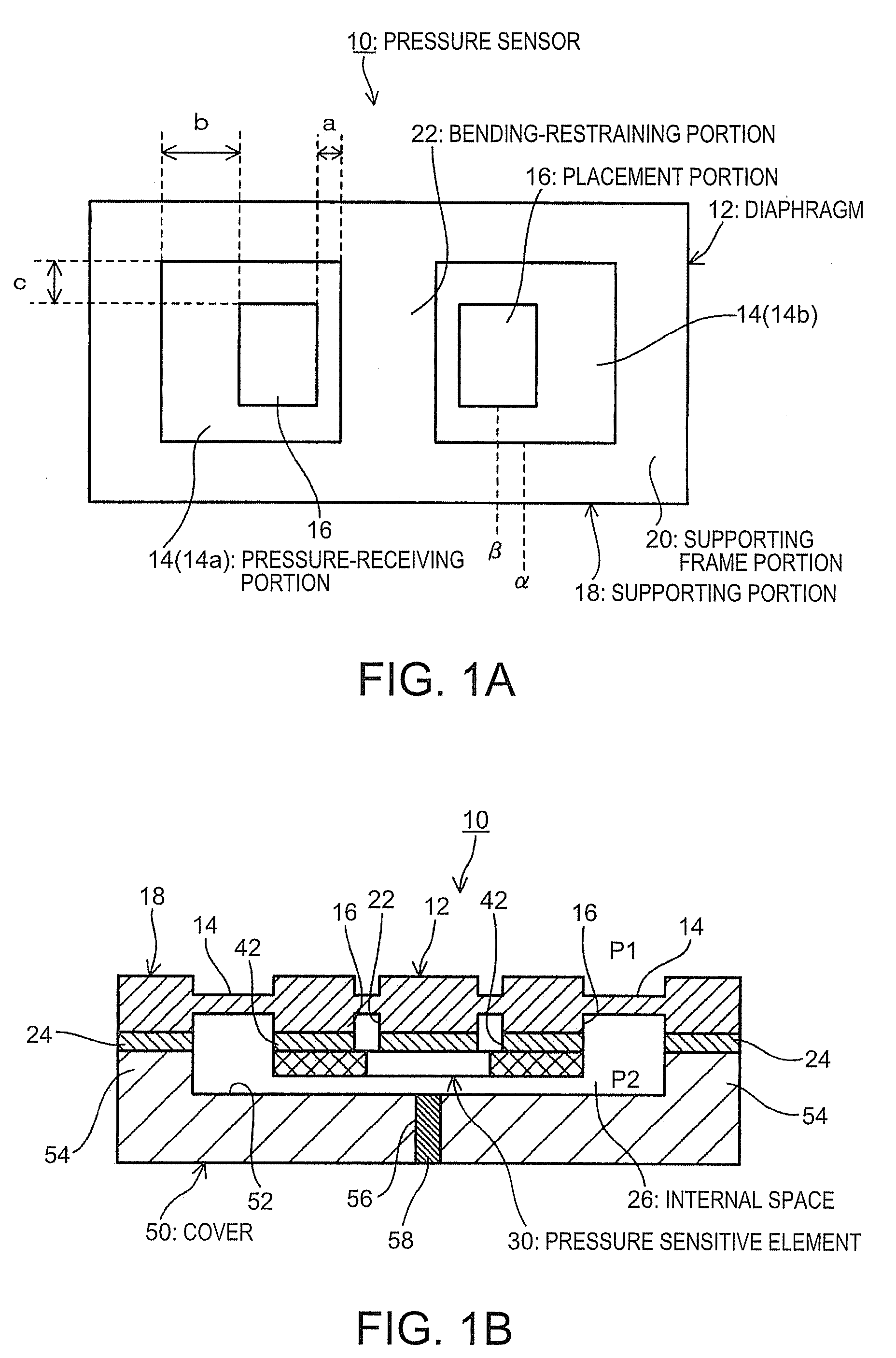Pressure sensor having a diaphragm having a pressure-receiving portion receiving a pressure and a thick portion adjacent to the pressure-receiving portion
a diaphragm and pressure sensor technology, applied in the direction of fluid pressure measurement by mechanical elements, fluid pressure measurement using elastically deformable gauges, instruments, etc., can solve the problems of reducing narrowing the variable oscillation frequency range, and deteriorating the resolution power of pressure measurement, so as to increase the breaking limit of the pressure sensitive element, widen the working pressure range, and prolong the life
- Summary
- Abstract
- Description
- Claims
- Application Information
AI Technical Summary
Benefits of technology
Problems solved by technology
Method used
Image
Examples
first embodiment
[0062]The pressure sensitive element 30 used for the pressure sensor 10 has a central portion thicker than its both ends. That is, the double-ended tuning fork resonator element 32 used as the pressure sensitive element 30 has the base 38 having a thickness thicker than that of the resonating arms 34 allows the pressure sensitive element 30 to step over the bending-restraining portion 22, as shown in FIG. 7B. The pressure sensitive element 30 may be bonded to areas, indicated with broken lines in FIG. 7A, of the pressure-receiving portion 14 with the connecting member 42 so that the bonding position of the pressure sensitive element 30 and the pressure-receiving portion 14 is the same as that of the This structure allows the pressure sensitive element 30 to receive a compressive stress. The cover 50 is bonded to the lower surface of the diaphragm 72 so that the recess 52 faces the diaphragm 72. The internal space 26 formed by the cover 50 and the diaphragm 72 is made into a vacuum ...
fourth embodiment
[0068]A diaphragm 74 of the fourth embodiment includes the supporting portion 18, the pressure-receiving portion 14, and the placement portion 16. The upper surfaces of the supporting portion 18 and the pressure-receiving portion 14 form the same plane. The lower surfaces of the supporting portion 18 and the placement portion 16 are protruded downwardly from the lower surface of the pressure-receiving portion 14. The under surface of the supporting portion 18 is protruded downwardly from the lower surface of the placement portion 16. The supporting portion 18 includes the supporting frame portion 20 and a bending-restraining portion 76. The bending-restraining portion 76 is disposed between the first pressure-receiving portion 14a and the second pressure-receiving portion 14b. The supporting portion 20 surrounds whole of the first pressure-receiving portion 14a and the second pressure-receiving portion 14b.
[0069]The bending-restraining portion 76 is composed of two portions each pr...
fifth embodiment
[0080]The diaphragm 82 of the fifth embodiment may have its flat upper surface as shown in FIG. 6B. The diaphragm 82 of the embodiment also may not include the placement portion 16 provided to the pressure-receiving portion 14 as shown in FIGS. 7A and 7B.
[0081]A sixth embodiment of the invention is now described. In the embodiments described above, the pressure sensitive element 30 is housed in the internal space 26 formed by the diaphragm and the cover 50. The pressure sensor 10 of the invention, however, may have a three-layer structure in which a pressure sensitive sensor provided with a frame is sandwiched between the diaphragm 12 and the cover 50. The pressure sensor 10 having the three-layer structure will be described in the sixth embodiment. The pressure sensor having the three-layer structure can be applied to the first through third embodiments. The structure will be described in which the pressure sensor 10 of the first embodiment employs the three-layer structure. In the...
PUM
| Property | Measurement | Unit |
|---|---|---|
| pressure | aaaaa | aaaaa |
| pressure sensitive | aaaaa | aaaaa |
| frequency | aaaaa | aaaaa |
Abstract
Description
Claims
Application Information
 Login to View More
Login to View More - R&D
- Intellectual Property
- Life Sciences
- Materials
- Tech Scout
- Unparalleled Data Quality
- Higher Quality Content
- 60% Fewer Hallucinations
Browse by: Latest US Patents, China's latest patents, Technical Efficacy Thesaurus, Application Domain, Technology Topic, Popular Technical Reports.
© 2025 PatSnap. All rights reserved.Legal|Privacy policy|Modern Slavery Act Transparency Statement|Sitemap|About US| Contact US: help@patsnap.com



